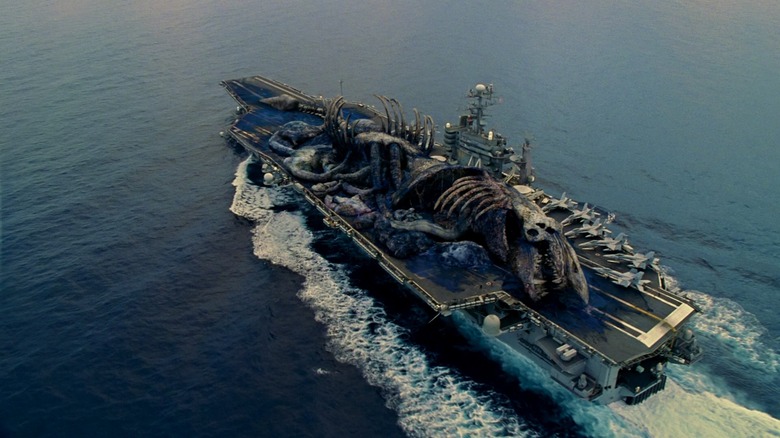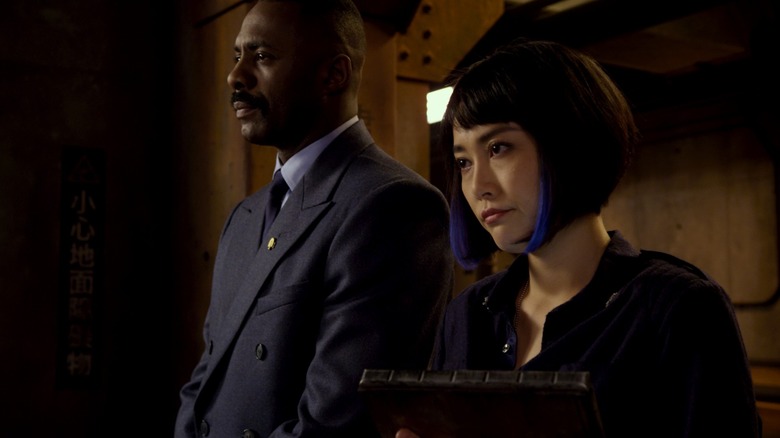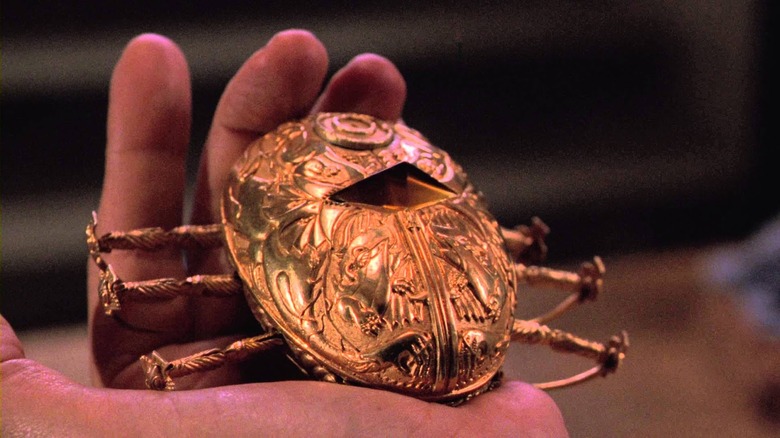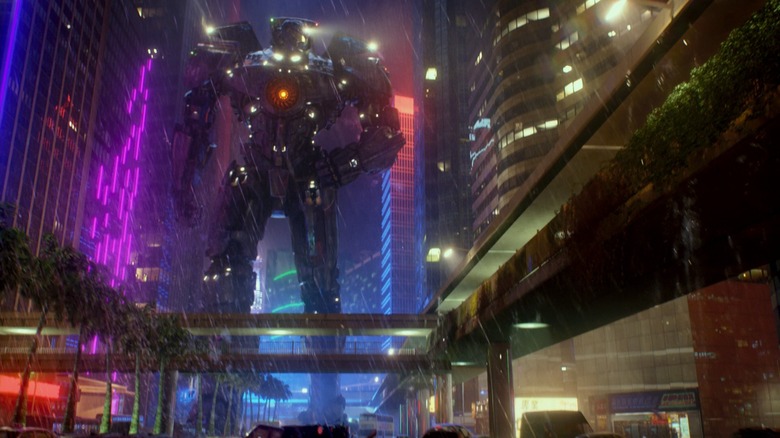How 'Pacific Rim' Drew Me Into Guillermo Del Toro's World Of Monsters
Guillermo del Toro is a celebrated filmmaker whose stock has only risen that much more since he won the Academy Award for Best Director earlier this month. Years before he won, del Toro already had a loyal following among cinephiles, with admirers of his output banging the drum loudly for him as a visionary director, a true auteur. But even after seeing Pan's Labyrinth and his three comic book movies — Blade 2, Hellboy, and Hellboy: The Golden Army — I remained somewhat aloof about del Toro and his work. Everyone probably has one of those critically acclaimed filmmakers or films, some well-regarded name, that they view across an emotional distance like that. The name might hold a certain academic interest for you as a movie-lover, but for whatever reason, it just doesn't match your taste.
For me, del Toro was that guy. I could appreciate the films of his that I had seen without ever nurturing any particular fondness for them — not even enough, really, to call myself a casual fan. It wasn't until 2013 that the unlikeliest of Del Toro movies would come along to break me out of that clinical detachment.
Monsters, misunderstood and otherwise, are a recurring motif in Del Toro's filmography, but it wasn't until he scaled the monsters up and employed the concept on the world stage with a big crazy kaiju-versus-mechs movie that I suddenly found myself responding to his vision. All it took was a summer popcorn flick called Pacific Rim — whose sequel, Pacific Rim: Uprising, is out today — to finally catch me in the web of his creature and ghost-filled tales of dark fantasy and gothic horror.
When Monsters and Mechs Collide
Mecha anime and Japanese kaiju films are two genres that Hollywood has flirted with in different ways, with giant robots and monsters headlining such franchises as Transformers, King Kong, and Godzilla. Technically, the Transformers robots are not mechs in that they are not piloted machines, but until Pacific Rim, they were (unfortunately) the closest live-action frame of reference that the majority of Western moviegoers would probably have for the concept of battle bots as big as buildings.
Pacific Rim is the best live-action mech movie ever made. It doesn't have a lot of competition in that category, but for fans of Neon Genesis Evangelion, it might be the closest we ever get to a big-budget, non-animated version of that kind of story. It's a wonder no high-profile American movie before this ever thought to utilize the delicious high concept of robots slugging it out with monsters on a massive scale. James Cameron's Aliens did give us that memorable power loader vs. xenomorph queen fight, but it's as if del Toro watched that fight and had that quote from Inception rattling around in his brain: "You mustn't be afraid to dream a little bigger, darling."
With Cameron holding his beer (and apparently ransoming his father from Mexican kidnappers?), del Toro delivered an appropriately outsized blockbuster where the mechs hold cool names like "Gipsy Danger" and the monsters are classified similar to hurricanes, with a category 5 Kaiju being a thing that inspires godlike fear as it swims up through an interdimensional portal in the depths of the ocean, ready to lay waste to human civilization. The influence of H.P. Lovecraft can be felt here ... years ago, Del Toro tried to mount an adaptation of Lovecraft's At the Mountains of Madness starring Tom Cruise, only to back burner the project indefinitely when Ridley Scott's Prometheus came along, bearing too close a resemblance to it.
Fortified by a rousing Ramin Djawadi score (Game of Thrones, anyone?), Pacific Rim is a movie that ushered in something of a kaiju renaissance at Legendary Pictures. Legendary has since begun developing its own MonsterVerse with the aforementioned Godzilla and King Kong. There was even talk that Pacific Rim could cross over with that MonsterVerse at some point.
This is a movie where a single monster carcass fills up a whole aircraft carrier. Mechanical titans wade into the ocean to defend coastal cities in the rain; there they encounter huge crashing waves inspired by The Great Wave off Kanagawa, the iconic Japanese woodblock print by Katsushika Hokusai. When they've had their arms torn off and chest impaled by knife-head sea leviathans, they stagger ashore and collapse with thundering finality on snowy Alaskan beaches. And that only takes us through the movie's 16-minute cold open. There's much more after that. Just when you think you've seen it all in Pacific Rim, a colossal monster sprouts bat wings and starts flying up into space with a humungous mech in tow.
Part of what makes the movie work is the tactility of its mechs, how they assemble before our very eyes and we can see all their inner workings as the camera cuts back and back and forth between what's happening outside and inside the cockpit of the so-called "Jaegers" — whose pilots are minuscule and all too vulnerable. It's a natural extension of del Toro's clockwork fetish: he wants to show all the grinding gears and let you hear the metal creaking. Every blow is felt inside the cockpit and when sparks fly, you know the Jaeger pilots are in trouble.
Add to this the faux-technical details: how the Jaegers require a neural interface that is too much for one human brain to handle, and so they must be operated by a pair of "drift-compatible" pilots, each of whom controls one hemisphere of the system. It takes time for the system to boot up; the technicians in the control room have to wait until the "neural handshake" between pilots is calibrated. Details like these, hooey as they might sound, lend a realistic effect to the action because that action is happening in a universe with pre-established rules, limitations to its technology.
Apart from the Jaegers, there are other neat world-building aspects in Pacific Rim like the existence of "bone slums" in cities where shanty towns have popped up around Kaiju remains. del Toro takes obvious delight in dissecting the monsters down to their base parts. The idea of a black market for monster organs is just one of the many things that gives this movie a sense of comic book glee. When Charlie Day's character starts running around like a kid in a candy shop, geeking out over all the different specimens on display — only to wind up full-on mentally interfacing with a monster brain — you can tell Del Toro shares his giddy pleasure.
Human Heroes and Human Monsters
In Pacific Rim, the characters all have colorful names like Stacker Pentecost and Hannibal Chau. But the cast itself also has color because it's a truly international cast, whose characters are meant to be representative of a cross-section of countries united in the common goal of defending Earth. Maybe that's part of the reason why the film raked in so much more money globally than it did at the American box office. In China alone, the movie made a hundred million dollars. That could have been the result of a calculated business move — this was, after all, the same summer as the specially edited Chinese version of Iron Man 3 — but in Pacific Rim, when a three-armed Chinese Jaeger piloted by triplets helps serve as humanity's last line of defense, it at least feels somewhat more organic to the plot.
There's a lot of talk of inclusion these days in blockbusters and movies in general, and it's become increasingly common for Hollywood tentpole releases to cater to foreign markets, but Pacific Rim is a film that was ahead of the curve in that respect. It was inclusive before it was fashionable. Yes, the film's main character, played by Charlie Hunnam, very much fits the profile of what del Toro called "the blonde, square-jawed, anglo, super hip marine that knows [everything]." But actually, the film's two most interesting characters are a black general and a female Japanese pilot, played by Idris Elba and Rinko Kikuchi, respectively.
Elba always brings a steely presence to the screen; here we get to hear him spout eminently quote-worthy lines like, "We're canceling the apocalypse!" For her part, Kikuchi brings a real earnestness to the proceedings. She's strong and intelligent — capable of kicking ass, yet fleshed out with enough of a backstory to be more than just a one-note action heroine. Moreover, her surrogate father-daughter relationship with Elba's character provides something of an emotional grounding to the people in this world.
This is where Pacific Rim breaks a bit from del Toro tradition: in its unswaying allegiance to humans over monsters. Del Toro's films often use ghosts as a metaphor and paint a sympathetic portrait of creatures while casting bad-seed human individuals as the real monsters. The villain in his movies is frequently a mere man with visible wounds, be it an eye with a burst blood vessel (The Devil's Backbone), a mouth-widening slit cut through a cheek (Pan's Labyrinth), or two gangrenous fingers (The Shape of Water).
In Pacific Rim, that tendency takes a back seat. At a theater in Tokyo (perfect city for a kaiju flick), the film got me to sit back wide-eyed in my seat and bask in what Del Toro called the "operatic grandeur" of a giant monster movie where the humans are far from helpless. It also got me to sit up and pay more attention to del Toro as a filmmaker. As a comic book movie aficionado, I always held respect for what he did with Hellboy: how he rendered the character with practical effects and gave him such a winning personality. Now I found myself going back, rewatching both Hellboy films, and taking more of a shine to everything beyond the title character.
Two years later, I was equally drawn into the twisted psychodrama of Del Toro's haunted house film Crimson Peak. Previously, I had ignored the whole early section of his filmography, but now I found myself seeking out some of those titles, too.
When The Shape of Water, Del Toro's fairytale romance involving a fish man and mute woman, took home the Best Picture Oscar this year, many of his fans saw it as the rightful culmination of a storied career that began 25 years ago with a Mexican horror film called Cronos. That mainstream moviedom was only just now embracing del Toro's talent with its top award — the way it had already done with his friends Alfonso Cuarón and Alejandro González Iñárritu — just meant it was late to the party. Let's not forget: this is the guy who almost succeeded Peter Jackson as the shepherd of Middle Earth back when he was still attached to The Hobbit and it was still just two movies instead of a whole bloated trilogy.
Early del Toro
Before del Toro started making kaiju or comic book flicks, he spear-headed a trio of other interesting films. Cronos, his Spanish-language first feature, offers a unique twist on the vampire tale, when a white-haired old gentleman who runs an antique shop full of ticking clocks activates a golden scarab that locks itself to his hand with mechanical beetle legs.
Cronos would see del Toro hook up with two of his most fruitful collaborators: the late actor Federico Luppi, and a young Ron Perlman. In this movie, the monster is yet again a man whose skin peels away to reveal a hidden layer of alabaster underneath, as if his flesh were just a cocoon worn by something ancient and inhuman. Yes, blood is licked off the floor of a public restroom in this movie. Why wouldn't it be?
del Toro's second feature, Mimic, is a film that was famously comprised by interference from Bob and Harvey Weinstein back when the brothers were still controlling Miramax. The director's cut restores some of del Toro's creative vision and remains one of those '90s flicks that holds the faces of future stars and still manages to be engrossing despite its flaws. That the cast includes Charles S. Dutton would only seem to further position it as a corollary to Alien 3, another creature feature that saw an up-and-coming auteur (in this case, David Fincher) undergo a trial-by-fire thanks to studio meddling.
More B-movie than blockbuster, the plot of Mimic revolves around genetically engineered super cockroaches that have evolved to mimic humans. This is del Toro at his ickiest. In a weird way, the film almost plays now like an early sketch for The Strain, the FX television series that del Toro co-created (he also directed the pilot episode). That show, too, was set in a Manhattan where monsters who lived underground faced resistance from a ragtag band of CDC doctors, beautiful, brainy blondes, and blue-collar types with a working knowledge of subterranean New York.
The rough experience of his English-language studio film debut sent Del Toro back to the drawing board, where he would utilize a smaller budget to craft another Spanish-language feature. His third film, The Devil's Backbone, ranks as one of his very best.
Set in a haunted orphanage where a bomb dropped from the sky rests defused in the courtyard and pickled fetus jars sit on tables in the doctor's office, the film unfurls a beguiling tapestry of interconnected stories where the humans are as much ghosts as the spooky ghost boy who can be seen wandering around the place. "Suspended in time, like a blurred photograph, like an insect trapped in amber," each character is confined by their present set of circumstances while struggling with the weight of the past. The ghost just happens to be an especially frightening physical manifestation of that.
The Door to del Toro
The Devil's Backbone is a film I might never have discovered were it not for Pacific Rim. Yet it's a film that ranks right up there with the widely celebrated Pan's Labyrinth in del Toro's filmography. Both films are set in a Spain where the consequences of civil war impinge on the lives of innocent civilians. del Toro has even called Pan's Labyrinth a spiritual successor to The Devil's Backbone. Yet it wasn't until seeing the latter film that I had the impetus to rediscover the former film, gaining a new appreciation for it as a mournful masterpiece.
In a roundabout way, Pacific Rim is also the film that reintroduced me to Pan's Labyrinth, just as it introduced me to del Toro's early work and reintroduced me to the Hellboy films. Of course, when juxtaposed against the heart-wrenching fantasy-versus-reality narrative of Pan's Labyrinth, all the mech-versus-monster action in Pacific Rim doesn't add up to much in the way of thematic depth. But not every film has to be enjoyed on that level. Some films can just be enjoyed on the level of pure spectacle, and Pacific Rim, which is still del Toro's most commercially successful movie worldwide, is a prime example of that. It's not his best film, but it is his biggest, and for me, it was the door to del Toro.
I don't know if Pacific Rim: Uprising, the sequel helmed by first-time feature filmmaker Steven S. DeKnight (showrunner of the first season of Daredevil), will be able to capture the same unbridled love-of-kaiju magic that makes the first film pop so vibrantly. But hey, even if it disappoints, there's always the original to rewatch, not to mention some of the other films referenced throughout this ode to cinema's foremost purveyor of monster tales. What better way to close out the month of his Oscar win than with a Guillermo del Toro marathon?




